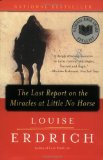Reading Guide Questions

Please be aware that this discussion guide will contain spoilers!
Introduction
Beginning with her National Book Critics Circle Award-winning first novel
Love Medicine, Louise Erdrich has spent nearly two decades carving her own fictional landscape from both the rough and mystical details of life on and around a North Dakota Indian reservation. In her masterful new novel,
The Last Report on the Miracles at Little No Horse, Erdrich weaves a tale that spans nearly a century, the strange and compelling story of Father Damien Modeste, a beloved reservation priest who has hidden his true identity as a woman beneath his cassock.
When the novel begins in 1996, movement is afoot to consider Sister Leopolda, the former Pauline Puyat, for canonization because of purported miracles associated with her. But Damien knows many dark truths about the deceased nun; truths learned in the confessional and pieced together from fragments of history and conjecture. The old priest writes to the Pope, the last of a lifetime of letters he has written to the Pontiff, to reveal the truth about the controversial Sister Leopolda.
Damien has remained silent about the Puyat woman for decades, not only because of the sanctity of the confessional, but also because she knew his own secret. He reflects back on his extraordinary life, unfolding the details of how Agnes DeWitt, a nun with an almost erotic obsession with the piano music of Chopin, is transformed into Father Damien. After a quixotic journey, marked by armed robbers and a terrible flood, Agnes assumes the identity of the real Father Damien, lost in the flood, and spends the next 84 years on the reservation as an integral part of the community.
With his own brand of religion, Father Damien melds the rigid dogma of Catholicism with the ancient mystical beliefs of the Obijwe. He becomes a great friend of the elder Nanapush, and his life intertwines with those of the Kashpaws, Lamartines, Lazarres, Morrisseys, Pillagers--characters who inhabit all of Erdrich's novels with Faulknerian deftness. Damien witnesses cataclysmic events that change reservation life forever--the devastating 1919 influenza epidemic, the white man's land grab, and finally the coming of the Bingo Palace--as well as the private passions, devotions and crimes of the Obijwe people he grows to love.
Later in his life, the Vatican sends a priest to investigate the holiness of Sister Leopolda. Father Jude encounters a maddening evasiveness from Father Damien about the would-be saint. As he stumbles through his own misguided search for meaning and transcendence, he too will be singularly changed by what he encounters.
A passionate and poetic writer, Louise Erdrich lends both elegance and wit to her most ambitious novel to date.
The Last Report on the Miracles at Little No Horse reaffirms Erdrich's status as one of America's best novelists.
Questions for Discussion
- Do you find Father Damien to be an attractive character? If so, why? Does it bother you that he is an impostor, a thief, a liar? Does it bother you that he spends money on a piano rather than on some other cause? He easily forgives others their sins, but can we forgive him that he has an affair with another priest?
- The novel invites comparisons between Leopolda and Damien. Make lists of some of their similarities and differences. Does Erdrich seem to want us to favor one over the other, or is she making through the strangeness of both of them a comment about the "miracles" of Catholicism?
- Father Damien goes to Little No Horse to convert the Ojibwe to Catholicism. By the end of the book has he nearly become converted to the very paganism he set out to replace?
- What do you make of the black dog that hounds Father Damien? Is it the devil? Does it really speak? Is it evidence that Damien is insane? Why did Erdrich risk having us even ask that last question by including the dog in the first place? If it is a devil who tempts Father Damien in the wilderness, does Damien become some sort of a Christ figure?
- Consider the various meanings of "passion" in this novel? Why does Erdrich use the word so often? What do you make of the implied allusion to the passion of Christ-or do you see no such implication?
- In this novel a very passionate woman spends most of her life impersonating a man. Along the way she becomes aware of certain ways that men typically behave, as well as how they are typically treated by others. Is there a message here about male-female roles and attitudes? Does Erdrich's use of both genders of pronoun (he/she, etc.) to refer to Father Damien confuse you, or does it make sense in the context of the story?
- In this novel more than any previous one, Erdrich gives untranslated words, phrases, and even sentences in the Ojibwe language. Why does she do this? Is it effective? Can you usually figure out from the context what the words, phrases, and sentences mean?
- Do you find Nanapush to be as attractive a character as Father Damien does? Is he, like his namesake Nanabozho, a trickster figure of mythological proportions, or is he just a funny, oversexed, foolish, and sometimes wise old man? How would you compare his sexuality with that of Father Damien?
- What are we to make of the Pope's failure to reply to any of Father Damien's letters during his lifetime? What are we to make of the Pope's willingness to write at the end of the novel after Father Damien is dead? Does this last make the novel feel more like comedy or tragedy? That is, does the final fax give the novel a happy or sad ending?
Unless otherwise stated, this discussion guide is reprinted with the permission of Harper Perennial.
Any page references refer to a USA edition of the book, usually the trade paperback version, and may vary in other editions.





